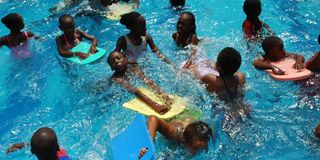How safe are our children in swimming pools at school?

Experts urge parents to be proactive and visit pools where swimming classes for children take place in order to assess their safety.
PHOTO/net
What you need to know:
Drowning is a leading cause of death among toddlers. So, who supervises children when they are excited in the pool? Are the teachers who accompany them, qualified poolside helpers? Or are children left at the mercy of one or two pool attendants?
She called me up recently in the night and with urgency and pain in her voice, pleading that I write about this matter: “I was one of those parents and school principals who used to be excited about taking my school children for swimming lessons, but after careful thought, I stopped. I could not continue having untrained teachers in swimming supervising children when they swim. When teachers take the children out for swimming, they are engrossed in their phones, half attentive to what is happening in the pool. I too was like that.
We have not yet had children drowning en mass in swimming pools around Kampala, but every time I see them in a school bus going for a swim, my heart skips a beat. Every teacher in a school that has a swimming pool or takes children to swim every so often should be a good swimmer and should be in the water with the children.”
Flavia Nampala is the proprietor and principal of Bereans School in Manyagwa. From this conversation, you may conclude she is paranoid or one making a mountain out of a molehill, but wait a minute, supposing she is right? Who supervises these children when they are excited in the pool? Are the teachers who accompany them, qualified poolside helpers? Or are childreb left to the mercy of one or two pool attendants? Do these teachers go with their swim gear when they take these children or they are just observers on the sidelines?
I recall asking myself these questions when my three-year-old went out swimming with her classmates last month. I was dead worried the entire time she was away, but of course as a man, you put on a bold face even when you are in tatters inside.
Drowning is a leading cause of death among toddlers. On average, three children aged four years drown every year in Uganda. Most drowning deaths occur at swimming pools, bathtubs, buckets, and Spas. Approximately two-thirds of toddler drowning deaths occur in water bodies, typically in dams, rivers, irrigation channels, and water troughs, as well as home pools and baths.
It is estimated that for every child who drowns, another 10 are hospitalised for non-fatal drowning and many have long-term effects such as permanent brain drainage. Toddlers are most at risk near water. Between one and four years are most at risk, because they are mobile and curious.
Advantages
That said, swimming is a full-body exercise-a physical exercise that works on all body muscles. It improves cardiovascular fitness by improving lung and heart health. According to a 2017 report commissioned by Swim England, swimmers had a 28 percent lower risk of early death and a 41 percent lower risk of death due to heart disease and stroke compared with those who never swim.
Swimming preserves knees, hips, and ankles because it is a low-impact sports activity compared to say tennis or running. When a flood occurs or when a boat capsizes, swimming will come in handy as a life-saving skill.
Harvard Medical School reports that a person who weighs 70 kilogrammes can burn 432 calories swimming compared to 266 calories walking at a moderate pace. Just like any exercise, swimming improves the quality of sleep and it is good for bone mineral density for post-menopausal women, according to BioMed Research International.
Water safety tips for children
Taking precautions to reduce the risk of your child drowning is very important. A toddler exposed to a water body, no matter how shallow, faces a significant risk of drowning.
It is important to install barriers such as pool gates and fencing around dams to restrict easy access to water bodies. Parents, teachers and pool attendants should learn cardiopulmonary resuscitation (CPR) and relevant first aid management skills to rescue children in case of an emergency.
Supervise your child around water
The most important preventive tactic is to actively supervise your children/child around water at all times. Active supervision means focusing all of your attention on your children all of the time when they are in, on, or around the water. It is not an occasional glance, while you are busy on your phone, but being in constant visual contact with your child. Twenty seconds is all that it takes for a toddler to drown.
Learn how to swim
Isaac Tumusiime, a swim coach at Greenhill Academy, Bugema University, and physical exercise lecturer and personal trainer at Makerere University suggests enroling for formal swimming lessons from the age of four. “Swimming programmes are available for children and the emphasis is on building confidence and encouraging the child to enjoy water, rather than teaching them how to swim,” he says. Tumusiime says children under five years of age may not be able to use their swimming skills during an emergency.
Visit the pools
Paul Muyimbo, a water safety awareness instructor and life guard trainer and founder of Sea-fits Swimming Academy in Entebbe, urges parents to be proactive and visit the swimming pools where the swimming classes for children takes place. “Please do this during the swimming activity time and personally assess for yourself the competencies of the team handling your children. Do not just buy swimsuits and sit back. Get to know what actually happens during swimming sessions,” he advises.




